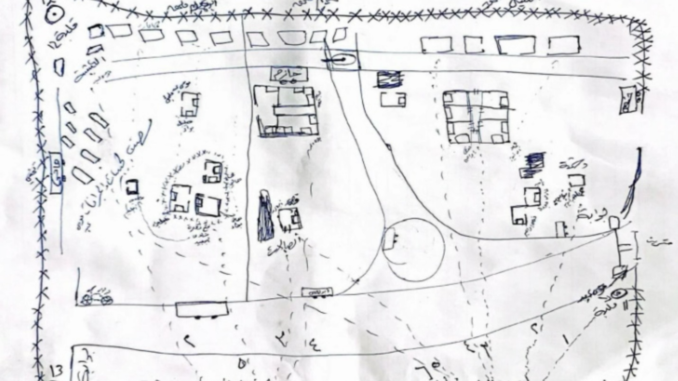The Hamas commander’s laptop included a detailed sketch of Nahal Oz, an IDF base located on the Gaza Strip fence.
By David Isaac, JNS 7 December 2023

Israeli soldiers seen around the destruction caused by Hamas terrorists on Oct. 7, 2023 in Kibbutz Kfar Aza, Nov. 2, 2023. Photo by Arie Leib Abrams
New documentation, including the laptop of a key Hamas commander, offers additional proof of the terrorist group’s meticulous planning of the Oct. 7 massacre.
The field intelligence unit of the Israel Defense Forces’ Military Intelligence Directorate, known by the Hebrew acronym AMSHAT, released the documents on Monday.
The material provided to JNS by the IDF came from a laptop belonging to the head of Hamas’ Nukhba Force, who took part in the attack. It was recovered in southern Israel.
Uploaded to the laptop was a notebook with detailed plans to conquer the army’s Nahal Oz base adjacent to the border fence along the northern Gaza Strip.
It included a hand-drawn sketch of the base, providing a visual representation of the strategic details in the notebook. The illustration, revealing accurate knowledge of the base, suggests Hamas had help from within.
(An Israeli intelligence source cited by The Guardian said the map revealed “inside knowledge … almost certainly from a Hamas spy.”)

Sketch of the IDF’s Nahal Oz base found in the Hamas commander’s laptop. Credit: IDF.
Prior to Oct. 7 many Arabs from Gaza entered Israel regularly for work (17,500 daily at the time of the attack), and a week after the attack, Israeli security services had already begun investigating the possibility that some of these individuals had passed information to Hamas.
Massacre survivors have reported that terrorists knew about their communities in great detail. Boris Volovik, a member of the 12-man security team of Kibbutz Nir Am, one of the few kibbutzim to mount a successful defense, told Knesset TV on Nov. 16, “The terrorists knew where the armories were on every single kibbutz and where the military security coordinators lived.”
Volovik said in nearby Kibbutz Kfar Aza, one of his friends was killed when he approached the armory and was ambushed. The military security coordinator at Kibbutz Kissufim was ambushed at his home, he said.
While day workers from Gaza were employed in these communities, the IDF assured JNS that they were not allowed to work on IDF bases.
However, according to Brig. Gen. (res.) Amir Avivi, founder and chairman of the Israel Defense and Security Forum (IDSF), that’s not quite true.
“You have Arabs working in bases, especially in construction, and certainly in towns. And I think that Hamas might indeed have gotten intelligence from construction workers,” he said.
These Arabs may have been from Gaza, or from Judea and Samaria, or may even have been Israeli Arabs, he said. “A company bids for a construction job. It’s an Israeli company. But then they take subcontractors and the subcontractors are Palestinian workers,” he added.
Avivi also doesn’t rule out the possibility that out of the half-million or so officers and soldiers in the IDF, “three or four are actually spying—cooperating with the enemy. It can happen.”
The plans found on the laptop included instructions for securing Israeli hostages, such as, “Cover the eyes and tie the hands of all adult hostages (men and women)” and “Kill those who cause trouble and anyone who tries to escape.”
A list of “Important Words in Hebrew” was provided for terrorists to communicate with hostages. It included such phrases as, “Get down,” “Do not look back,” “Where is the head of the kibbutz?” and “Put your hands up and spread your legs.”
(Hamas terrorists captured some 240 Israelis and foreign citizens—138 are still being held—on Oct. 7).
The newly released plans underscore just how ignorant Israel’s security forces were about the terror group’s intentions and mindset.
At a press briefing at AMSHAT headquarters on Monday, IDF officers admitted that Hamas had been planning its attack for more than a year, confirming reports last week in The New York Times and elsewhere that the IDF had plenty of forewarning, which it ignored.
According to the Times, Israel had been presented with a 40-page document, code-named “Jericho Wall” by Israeli authorities, which outlined a Hamas invasion in which terrorist forces would overwhelm IDF fortifications along the Gaza fence.
“Hamas followed the blueprint with shocking precision,” the Times reported.
Head of IDF intelligence Maj. Gen. Aharon Haliva and then-head of the IDF’s southern command Eliezer Toledano were presented with the “Jericho Wall” document but did nothing, according to the report.
When a Hamas expert from the IDF’s Unit 8200 and her commander, desperate to get their detailed information of an impending invasion to IDF higher-ups, waylaid Haliva, he dismissed their warnings as nonsense.
IDF leadership had come to believe that Hamas was deterred, and that it had become pragmatic, more interested in ruling the Gaza Strip than waging war against Israel. This mindset was expressed by Haliva during a now-widely replayed interview at Reichman University’s World Summit on Counter-Terrorism in September of last year.
Haliva said he foresaw “five years of quiet in the southern arena” after “Operation Guardian of the Walls” (May 2021).
“In Gaza, I identify that alongside our military force and deterrence, the actions taken by Israel to stabilize the economy, allow in workers and improve the quality of life all have the potential to create years of quiet,” he added, underscoring Israel’s now clearly mistaken belief that Hamas was interested in improving the economic lot of Palestinians.
IDSF’s Avivi told JNS that one of the chief misconceptions by which IDF leadership operated, and which led to Oct. 7, was their concept of deterrence and belief that “Hamas will not fight if we give them some economic relief, trying all the time to connect the economy to what they do or don’t do.”
Avivi said he’s been trying to convince IDF leadership for years that a Marshall Plan, the U.S. post-World War II project to rebuild Western Europe, including Germany, with foreign aid, isn’t appropriate for Gaza.
“When I was a general in the army, I told then-Chief of Staff Gadi Eizenkot, ‘The Nazis were completely destroyed … and then they implemented the Marshall Plan. But [Hamas] feels hardly touched. And you think that you’re going to appease them with money, or whatever? It doesn’t work like that,” said Avivi.
Asked what Eizenkot’s response had been, Avivi said, “These guys were completely off. …Psychologically, people are looking for some sense of control. They want to feel that they control reality, and they cannot deal with the fact that they’re simply not controlling anything.”



Leave a Reply
You must be logged in to post a comment.